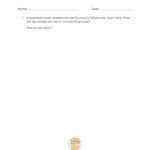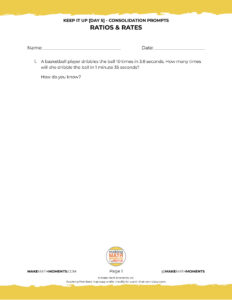Task Teacher Guide
Be sure to read the teacher guide prior to running the task. When you’re ready to run the task, use the tabs at the top of the page to navigate through the lesson.
In This Task…
Students will demonstrate the concepts and skills that they have developed through this context and learning experience.
Intentionality…
The purpose of this assessment is for student to demonstrate their understanding of the following big ideas:
- A ratio is a multiplicative comparison between two or more quantities;
- There are two types of ratios; a composed unit ratio and a multiplicative comparison ratio;
- A composed unit is often (not always) a ratio with two distinct units;
- Unknown quantities in a ratio relationship are often most efficiently revealed through multiplicative thinking strategies rather than additive thinking strategies;
- A composed unit ratio can be scaled in tandem;
- Ratios can be constructed by comparing a part to its whole (part-to-whole) or comparing a part to another part of the whole (part-to-part).
- Ratios can be represented using the separator “to” or a colon “:”. Two quantities from a ratio relationship can also be represented as a quotient through the use of the division symbol “÷” or with the fraction bar.
- When you divide two quantities in a composed unit ratio through partitive division, you reveal a rate.
- Equivalent ratios are derived from the same rate;
- An infinite number of equivalent ratios can be revealed to assist in determining an unknown quantity from a ratio relationship;
- Ratio problems can be represented and solved using a variety of strategies, tools, and representations; and,
- A multiplicative comparison ratio where one quantity, x, is compared to a whole of 100 can be written as a ratio (i.e.: x:100) or as a percent (i.e.: x%). Despite the rate language of “per” being used in the term “percent” (meaning per 100) as well as the common practice of using percents to describe growth or decay rates, a percent remains a ratio until the quantities are divided partitively.
The independent assessment will allow students to demonstrate concepts and skills related to the following learning goals:
- I can recognize how ratios compare two quantities
- I can generalize that ratios relate two quantities within a given situation in a multiplicative relationship
- I can use ratio and rate reasoning, including equivalent ratios, to interpret and solve problems
- I can use tape diagrams, tables and other models to find equivalent ratios and compare ratios
- I can recognize that ratios and proportional relationships involve looking for structure
- I can calculate a percent of a quantity and solve problems
Students might write and/or model their answers independently. Students can also be interviewed by their teacher.
An alternative assessment opportunity should be offered if this tool will not successfully capture what the student knows, understands, or can do.
What You’ll Need…
A variety of tools for students to use to think through the problems, including, but not limited to:
- Linking cubes, Omnifix cubes or tiles
- Cuisineaire rods
- Grid paper
- Whiteboards & markers
Math Talk
String of Related Problems
This math talk is crafted in a way to foster discussion and the construction of viable arguments. The idea is for students to convince their peers about whether a representation matches a given expression or not.
These prompts promote students’ reasoning and proving as they connect visual representations to symbolic representations.
Find the Imposter #1
Login/Join to access the full teacher guides, downloadable slide decks and printable handouts for this lesson and all problem based units.
Find the Imposter #2
Login/Join to access the full teacher guides, downloadable slide decks and printable handouts for this lesson and all problem based units.
Find the Imposter #3
Login/Join to access the full teacher guides, downloadable slide decks and printable handouts for this lesson and all problem based units.
Find the Imposter #4
Login/Join to access the full teacher guides, downloadable slide decks and printable handouts for this lesson and all problem based units.
Assessment
Assessment Considerations
Login/Join to access the full teacher guides, downloadable slide decks and printable handouts for this lesson and all problem based units.
Assessment: Ratios, Proportions and Percents
Login/Join to access the full teacher guides, downloadable slide decks and printable handouts for this lesson and all problem based units.
Questions: Ratios, Proportions and Percents
Login/Join to access the full teacher guides, downloadable slide decks and printable handouts for this lesson and all problem based units.
Download Editable/Printable Handout
Become a member to access purposeful practice to display via your projector/TV, download the PDF to upload to your LMS and/or print for students to have a physical copy
Resources and Downloads
Lesson Tip Sheet

Download the lesson plan in PDF format so you can keep it handy and share with colleagues.
Videos & Images
 Download the videos, images, and related media files to your computer to avoid streaming.
Download the videos, images, and related media files to your computer to avoid streaming.
Keynote Slides
 Download in Apple Keynote format to avoid streaming video and run the lesson smoothly.
Download in Apple Keynote format to avoid streaming video and run the lesson smoothly.
PowerPoint Slides
 Download in Microsoft PowerPoint format to avoid streaming video and run the lesson smoothly.
Download in Microsoft PowerPoint format to avoid streaming video and run the lesson smoothly.
Printable Handout

Download/Edit the handout so you can keep it handy and share with colleagues.
Explore The Entire Unit of Study
This Make Math Moments Task was designed to spark curiosity for a multi-day unit of study with built in purposeful practice, and extensions to elicit and emerge mathematical models and strategies.
Click the links at the top of this task to head to the other related lessons created for this unit of study.
Find the Imposter #1
Login/Join to access the full teacher guides, downloadable slide decks and printable handouts for this lesson and all problem based units.
Find the Imposter #2
Login/Join to access the full teacher guides, downloadable slide decks and printable handouts for this lesson and all problem based units.
Find the Imposter #3
Login/Join to access the full teacher guides, downloadable slide decks and printable handouts for this lesson and all problem based units.
Find the Imposter #4
Login/Join to access the full teacher guides, downloadable slide decks and printable handouts for this lesson and all problem based units.
1. Basketball Dribble
Login/Join to access this full lesson, teacher guides, downloadable slide decks and printable handouts for this lesson and all problem based units.
2. Smoothie Recipe
Login/Join to access this full lesson, teacher guides, downloadable slide decks and printable handouts for this lesson and all problem based units.
3. Internet Downloads
Login/Join to access this full lesson, teacher guides, downloadable slide decks and printable handouts for this lesson and all problem based units.
4. Counting Cookies
Login/Join to access this full lesson, teacher guides, downloadable slide decks and printable handouts for this lesson and all problem based units.
5. Hockey Stats
Login/Join to access this full lesson, teacher guides, downloadable slide decks and printable handouts for this lesson and all problem based units.
Download Editable/Printable Handout
Become a member to access purposeful practice to display via your projector/TV, download the PDF to upload to your LMS and/or print for students to have a physical copy




